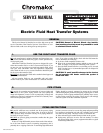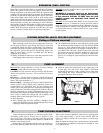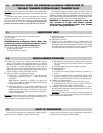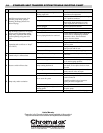
10. OPERATING ABOVE THE MAXIMUM ALLOWABLE TEMPERATURE OF
THE HEAT TRANSFER SYSTEM OR HEAT TRANSFER FLUID
11. INSUFFICIENT HEAT
12. MISCELLANEOUS PROBLEMS
13. START UP SUPERVISION
DO NOT attempt to operate any heat transfer system or heat trans-
fer oil at temperatures higher than those recommended by the man-
ufacturer.
Chromalox heat transfer systems are designed for a particular
maximum temperature. If you do not know this design tempera-
ture, check with the Chromalox factory or consult the individual
instruction sheet for that system. Exceeding the designed tem-
perature of the heat transfer system will void our warranty.
Exceeding the temperature limits of the heat transfer fluid will
cause its thermal breakdown or degradation. This will result in the
formation of sludge in the system and carbon on the heating elements
and eventually cause pump and heater failure. If you do not know this
maximum temperature, check with the fluid manufacturer.
WARNING: In hazardous or explosive areas, the
pipe surfaces of oil type heat transfer systems
could achieve temperatures higher than allowed
for Class I, Group D, Division I.
The following are the major causes of insufficient heat:
A. Low voltage.
B. Blown fuse in heater circuit.
CAUTION: Hazard of Electrical Shock. Make sure
all electrical power is disconnected before servic-
ing or replacing any electrical component.
C. System too small for application (not enough kW).
1. Increased work load.
2. Changed product or process.
D. Restriction in flow of heat transfer fluid to process. (See No. 3
Piping Restrictions)
E. Thermostat set too low.
F. Piping or process not insulated. This is a common fault. The
piping in heat transfer systems is shipped from the factory
uninsulated, only the heating chamber is insulated. The piping
in the heat transfer system should be insulated at the same time
the piping from the system to the process is insulated.
A. Leaking pipe joints can be caused by poor threads, using the
wrong or old gaskets and unsupported piping. New gaskets
should be used whenever a flanged pipe joint is made. A good
rule of thumb for systems operating above 350°F is to use
flanged or welded connections on all pipe larger than 3/4”. On
high temperature systems, threaded pipe will loosen with heat-
ing and cooling of system and in time will leak.
B. Excessive leakage at stuffing box of pump.
1. Packed type — normal leakage rate is approximately five
(5) drops per minute when cold, 1 — 2 when at operating
temperature.
Note: Improper tightening of stuffing box gland will
always cause abnormal leakage and possible shaft damage
(see Instruction Sheet for unit).
2. Mechanical seal type — water cooling of mechanical seals
is recommended when operating over 350°F. Most types
should not leak either water or oil. However, some water
cooled high temperature seals are designed to leak steam or
water at a constant rate.
DO NOT
connect cooling water to flush ports of mechanical seal
pumps. Water will be forced thru the seals and contaminate the oil.
(Check manufacturer for proper connections.)
3. Misalignment of pump will cause high leakage of oil pack-
ing type stuffing box and complete failure of mechanical
seal type.
4. Unusually high back pressure at high temperature.
C. Pump bearing failure.
1. Misalignment.
2. Cavitation (for causes of pump cavitation, see sections 3, 4
and 9).
3. Excessively high pressure at operating temperature. Can be
caused by incorrect or poor quality heat transfer fluid.
Water in a heat transfer fluid can also cause high pressure.
D. Spillage from expansion tank.
1. Tank too small to accept expansion of liquid in system.
2. Expanding pocket of air or steam in system forcing heat
transfer fluid to back-up into expansion tank.
E. Sludging of heat transfer fluid is caused by either too high a
heating element temperature or improper materials used in cus-
tomer’s piping or process.
DO NOT
use brass valves or fittings. Generally speaking on
oil type systems, no copper or copper bearing alloys should be in
contact with the heat transfer fluid.
Factory trained personnel are available upon request for those
customers who are unfamiliar with the initial start-up.
Contact your local Chromalox sales and application engineer list-
ed on back cover and request Bulletin PQ901.
-4-








